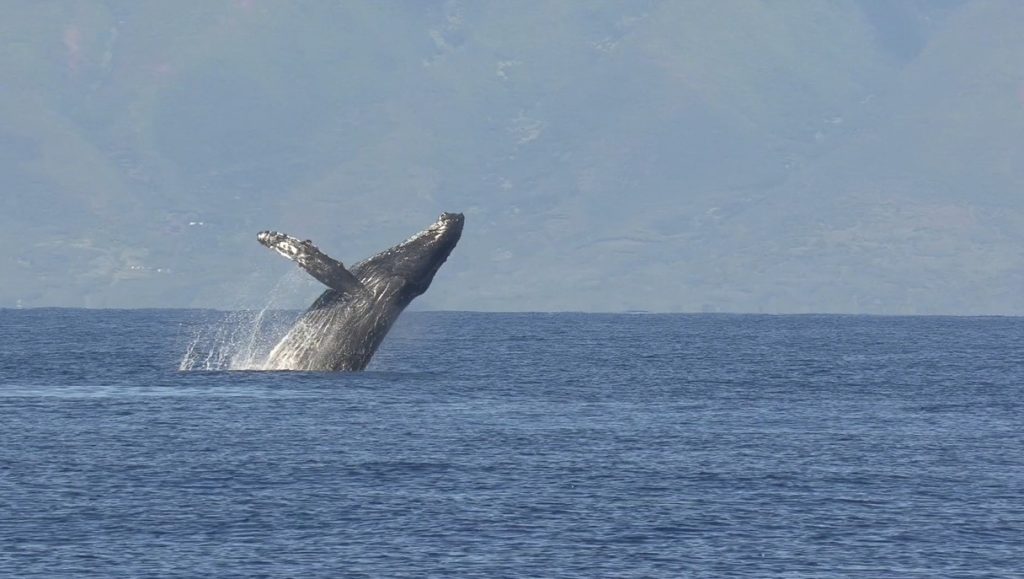01/10/23 – FIRST RESPONDERS TRAIN FOR HUMPBACK WHALE DISENTANGLEMENTS
Posted on Jan 10, 2023 in Aquatic Resources, Boating & Ocean Recreations, News Releases, slider| JOSH GREEN, M.D. GOVERNOR |
DAWN CHANG
CHAIRPERSON |
For Immediate Release: January 10, 2023
FIRST RESPONDERS TRAIN FOR HUMPBACK WHALE DISENTANGLEMENTS

To view video please click on photo or view at this link: https://vimeo.com/788036457
(Maalaea, Maui) – A dozen or more times each season, humpback whales while on their principal breeding and calving grounds within the Hawaiian Islands Humpback Whale National Marine Sanctuary (sanctuary) or nearby waters get spotted entangled in fishing gear or marine debris. In the worst cases this material can kill the animal.
When a report of a tangled whale comes in, a specialized, highly-trained group led by federal and state workers head out on a search and rescue mission. Freeing an entangled whale can take hours or even days.
Chad Yoshinaga, Safety Program Manager at NOAA’s Pacific Islands Fisheries Science Center, said, “My analogy is we’re looking for a single needle in a stack of needles in a gigantic haystack.” The quicker they receive reports about distressed whales from mariners or people on the shoreline the faster they can intercept it and begin the “rescue” part of their mission.
In December, experienced and novice whale disentanglement specialists took to the sea for several days of training and refreshing of their skills.
Ed Lyman wears several hats for NOAA, but during whale season in Hawai‘i he is the sanctuary’s Regional Large Whale Entanglement Response Coordinator under NOAA’s Marine Mammal Health and Stranding Response Program. He is leading this season’s training; the first since before the pandemic.
“We’re working around enormous, moving animals, at times in heavy seas and always from moving boats. The safety of our disentanglement teams is paramount. We obviously want to free the whales, but we have to do it without getting anyone hurt,” Lyman explained.
Training begins with a thorough on-board briefing, which includes a check on the experience level of each team member, their comfort level in performing various tasks, and how they’re feeling in general.
Responses often involve two vessels. The support boat that carries an inflatable boat that is aired-up in route and then launched when a tangled whale is spotted.
“It’s risky business trying to free a 40-ton whale, so you want to deal with the what-ifs. So, one boat is going to approach and work on the whale, while the other one is there to protect all the people involved,” Lyman said.
For training, the bow of the support boat carries a wooden whale tail, draped with various sizes of fishing line. It becomes the stand-in for a live animal to give everyone an opportunity to practice or learn how to throw grappling hooks and cut lines while bouncing around in the waves; all while managing a large knife at the end of a 14-foot or longer pole. It’s not easy work and requires years of practice and experience.
Whale disentanglement crew members earn designations that are part of an Incident Command System (ICS) from one to five, from least experienced to most experienced. Lyman says the ideal number of people to have involved in a disentanglement is eight.
“You need two or three people on the inflatable approach boat and you need a good five on the support boat to address all the roles. A helms person, a crew member, someone doing documentation, a gear person, and a safety officer. That’s someone who is not doing anything but watching the big picture.”
On the approach boat, the team typically includes a bow person watching the animal and holding onto gear, a helm person, and a safety person.
The DLNR Division of Aquatic Resources (DAR) is the state agency responsible for conserving and protecting all of Hawai‘i’s wildlife. DAR staff often partner with NOAA on whale rescues. For the latest training staff from Kaua‘i, O‘ahu, Maui, and Hawai‘i Island participated.
The DLNR Division of Boating and Ocean Recreation (DOBOR) also has a role to play.
“Together DAR and DOBOR deal with marine mammals, fishing, boats, moorings, fish aggregation devices and other things that whales get entangled in,” according to Jeannine Rossa, Acting State Co-Manager for the Hawaiian Islands Humpback Whale National Marine Sanctuary. “We have a marine debris reduction program, and we want to be part of the solution in reducing entanglement hazards,” she said.
It takes years of experience to become a top-level disentanglement expert, but no matter their level of experience the people who free whales are dedicated and passionate about what they do. It’s hard work and when a whale is freed they all agree there’s no better feeling.
# # #
(RESOURCES)
HD video – Hawai‘i Whale Disentanglement Training web feature:
HD video – Whale disentanglement training media clips (Dec. 6, 2022):
Photographs – Whale disentanglement training (Dec. 6, 2022):
https://www.dropbox.com/scl/fo/v1qf5qev8a0ukuquv8525/h?dl=0&rlkey=l6k134lyimd9fcacbg4znlfu1
Media Contact:
Dan Dennison
Senior Communications Manager